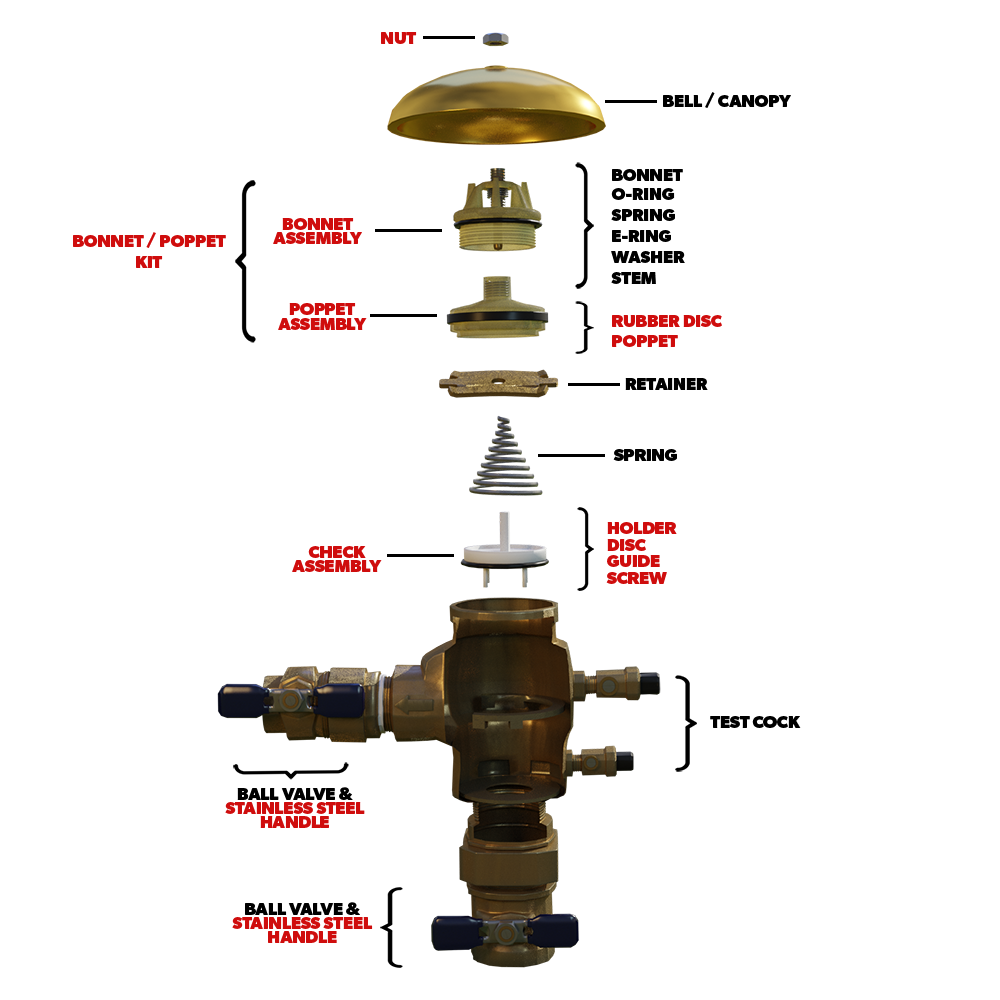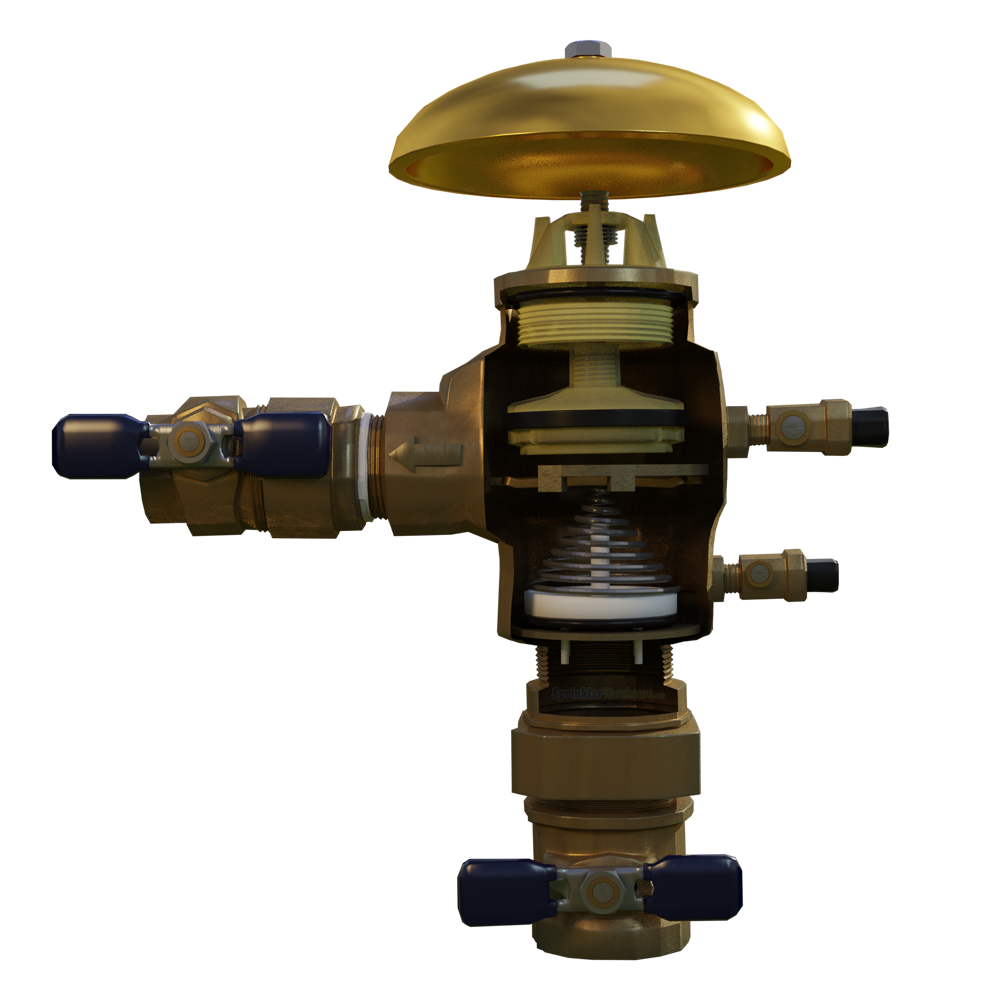
FEBCO Series 765 Pressure Vacuum Breakers are designed to be installed to provide protection against back siphonage of toxic or non-toxic liquids. They feature a durable bronze body and a check valve and air opening port in one assembly.
Pressure Vacuum Breaker assemblies shall be installed to withstand pressure for long periods and to prevent backflow of contaminated water into the potable water system in backsiphonage conditions. The Pressure Vacuum Breaker assembly shall consist of a single spring-loaded check valve which closes tightly when water flow through the assembly drops to zero, and a single air relief valve that opens to break the siphon when pressure drops to 1psi.
The assembly shall include two resilient seated shut-offs and two resilient seated test cocks, considered integral to the assembly. Assemblies must be factory backflow tested. The check valve and air inlet valve must be constructed to allow in-line servicing of the assembly. The valve body shall be constructed of bronze. The check, poppet and bonnet assembly shall be constructed of engineered plastic to protect the valve body from freeze damage. Pressure Vacuum Breaker assemblies shall be installed a minimum of 12" (300mm) above the highest downstream outlet, and the highest point in the downstream piping.
The assembly shall be rated to 150psi working pressure and water temperature from 32 degrees F to 140 degrees F. The assembly shall meet the specifications of the USC - FCCC & HR Manual. Pressure Vacuum Breaker assemblies shall be FEBCO ½ Series 765 or prior approved equal.
Materials
WARNING!
Irrigation systems supplied by domestic or private potable water systems are considered to be a potential pollution hazard to the water supply. These systems must include protection to prevent possible backflow of irrigation water into the potable water supply.
Federal law requires a proper backflow device to be installed on any watering system to prevent contamination of the supply; whether it be pump or city water. Check your local water authority for installation requirements & codes. In many rural areas; specific requirements for landscape irrigation systems may not be covered in local plumbing codes and/or enforcement may be limited. HOWEVER...limitation in local authority does not alter the basic requirement for protection of the potable water supply.
*Red indicates repair parts sold at the Sprinkler Warehouse
Irrigation Systems that are fueled either by private or domestic potable water supplies can cause contamination hazards to the water system. Federal Law requires these irrigation systems have a backflow prevention device installed to prevent backsiphonage of toxic or non-potable solutes into the water supply. We encourage you to check with your local water authority to learn installation requirements and codes.
Pressure vacuum breakers are not only highly beneficial for your health and safety but are often required by law as well depending on the nature of your water supply. In most cases your sprinkler system is supplied by potable water systems that are used for a variety of things from bathing, cleaning to drinking. Understandably, we wouldn't want the water that is in the sprinkler system, full of contaminants such as fertilizers and insecticides, to reenter the potable water supply.
In order to install a 765 PVB, check with your local regulations, restrictions, and requirements for backflow devices. Make sure the 765 is in an easily accessible location for regular testing and maintenance. Next, flush the supply line of all foreign material, especially that which could pose a potential health risk. Remember that the pressure breaker should be installed at least 12 inches above the highest outlet in the irrigation system and the highest point in downstream piping.
Articles
Videos
The 765 features an all bronze body for strength, hardness, and durability, along with one check valve and air opening port, all in the same assembly. The lightweight, durable plastic poppet seals the air opening in low or no flow situations, and the 765 is designed for minimum head loss. All internal parts are serviceable from the top of the unit, and repair kits are easy to use and come with directions.
First, shut off the water to the irrigation system. Then close the inlet valve to the backflow, then open the test cocks. This will drain the backflow. Next, close the outlet valve to the backflow, and close the test cocks. Then turn the ball valves in the 765 series backflow to 45° positions, and outfit the device with a backflow bag.
First, shut off water to the backflow, then water from the backflow. Next, open the test cocks with a flathead screwdriver. Remove the nut from the bell, and then remove the bell. Then remove and replace the bonnet and poppet with a new bonnet and poppet. Be sure to hand tighten the bonnet, do not use a wrench. Finally, repressurize the system slowly. More detailed instructions can be found in our sprinkler school video library.
A PVB is a mechanical backflow with simple moving interior parts. It has a check valve and an independent air inlet, both spring-loaded, each working together to prevent water from entering the discharge side of the backflow. They also have two shut-off valves and often one or more test cocks.
| Brand | Febco |
|---|---|
| Product Type | Pressure Vacuum Breakers (PVB) |
| Test Cocks | 2 FEMALE |
| Max Working Pressure | 175 PSI |
| Hydrostatic Test Pressure | 350 PSI |
| Temperature Range | 32F to 140F |
| Main Valve Body Materials | Bronze |
| Elastomers | Nitrile |
| Springs | Stainless Steel |
| Warranty | 1 Year |
| Size | 3/4 in. |
| Connection | FPT |
| Lead Free | Not Lead Free |


